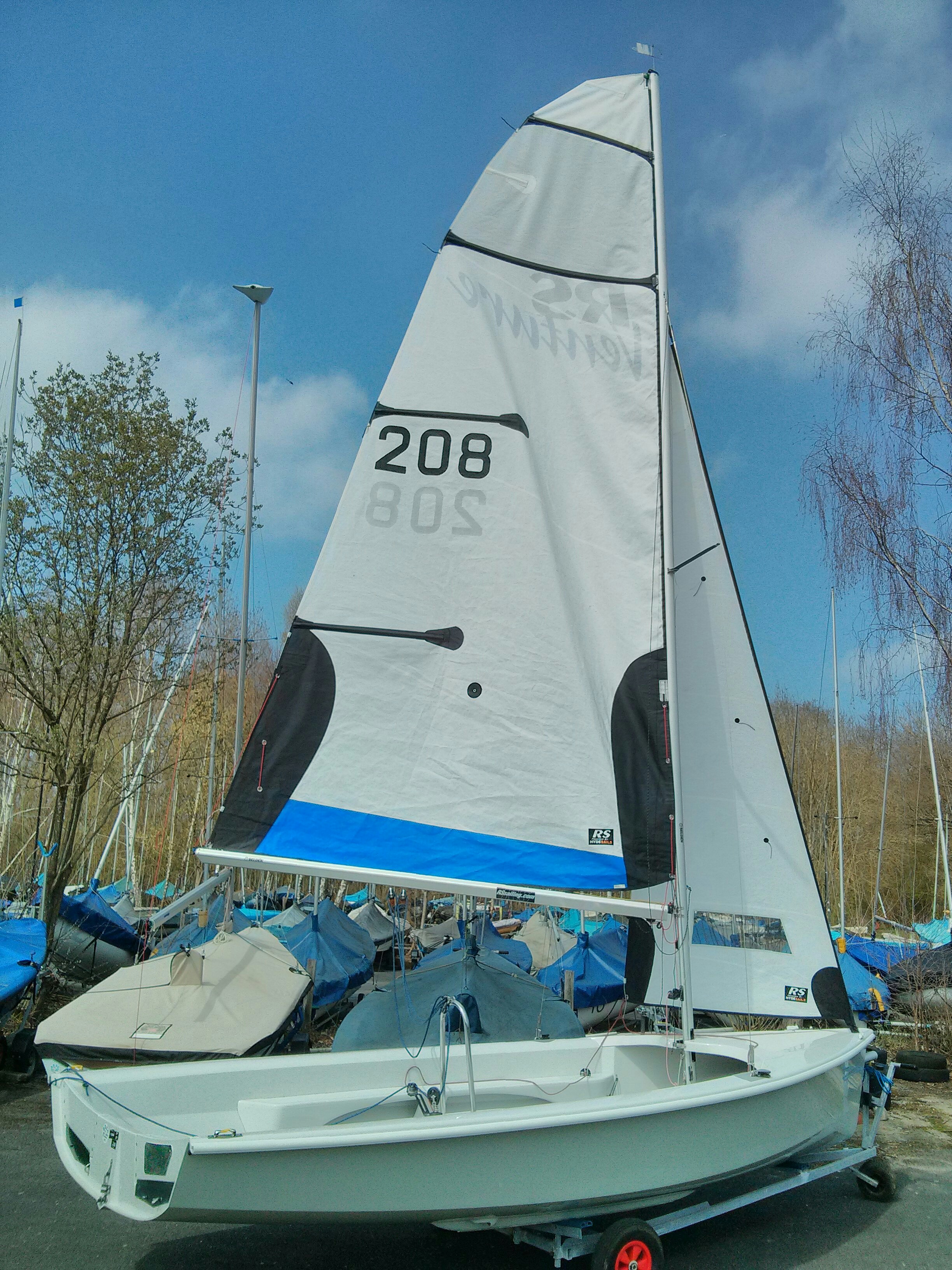RS Venture Rudder assembly
Rigging the Rudder
The rudder consists of a long (1.2m) aluminium foil with a central wing nut and two operating lines for holding the rudder in the up or down positions. Each of these lines has its own cleat. The hold down line has a ‘breakaway’ cleat, ie if the rudder strikes a submerged obstruction when sailing the cleat flies up and open releasing the line and saving the rudder from damage. To prevent the rudder from detaching from the boat in the event of a capsize the boat is also fitted with a rudder retaining spring tab. However these tabs certainly cannot be relied upon to prevent the rudder falling from its mounting during a capsize (wave action can cause the rudder to work loose from the tab) and, as a further safety measure, the top pintle (the upper steel pin) has a small hole into which a wire spring etc should be inserted. It is useful to tie a thin cord to the safety clip to prevent loss and aid removal. There is a convenient hole in the rudder headstock into which this cord may be threaded and tied off. When mounting the rudder on to the pintles make sure the spring tab is fully engaged and the safety clip is inserted. If the rudder falls out it will sink immediately!
The rudder lines rarely need renewing but the following gives some guidance on this task. The pull down line consists of a short length of 4mm rope, tied at one end to a fixed clip located by the breakway cleat. The other end passes through a small loose pulley and is brought back to the breakaway cleat. This arrangement provides a 2:1 advantage when locking the rudder down into the sailing position. The rudder wing nut should be tightened and then loosened until the pull down line can just be conveniently operated - the rudder should not be loose because this would affect the sailing. A rope tied to the becket of the loose pulley passes over the lower headstock pin and is fed into a small hole in the head of the rudder moulding. It is strongly recommended that a thinner, lower breaking strain nylon cord is used for this purpose with the intention that it will snap before damage occurs to the rudder - acting as a backup in case the breakaway cleat jams. Use a small stainless steel washer and knot to secure this line into the rudder notch. The purpose of the washer is to spread the load of any sudden shock which might otherwise pull the knot into the rudder moulding and split the fastening.
The pull up line is a single 4mm line fed through the rudder headstock over the top headstock bolts and down the rear edge of the rudder. The lower end is knotted into the rudder and the upper end when in use is fastened to the fixed cleat on the tiller head. Make sure the line is fed over the headstock bolts otherwise this line could jam the operation of the rudder.
Tiller Extension
The standard RS Venture tiller extension has a length of 1185mm. The universal joint is a Seasure MkIII 23.76 and has an extension insert diameter of 13.5mm to fit a 16mm overall width extension tube. The UJ base has fixing hole spacing of 1" (25.4mm). The red insert alone is a SeaSure 23.44 Standard Flexible UJ Set and is cheaper than the full UJ.
The rubber universal joint is a weak link and these sometimes break at the most inconvenient moments. When the time comes to replace the UJ, gently (without scratching the paintwork) file or grind down the heads of the rivet passing through the rubber tongue. Use a small sharp drill to carefully and slowly drill with light pressure into the remaining heads of the rivet. Do not drill into the extension tube - the purpose is to merely remove the rivet heads. The broken UJ tongue can then be pulled out of the extension tube together with the remnants of the rivet, and a new UJ pushed in. Rather than replace the rivet (a small pop rivet will secure the new UJ) a small self tapping screw eg. a window screw, will make it easier to renew the UJ next time round. With the new UJ in position in the tube use a small drill (2mm) to drill into the rubber and then insert and tighten the screw. The advantage of using a screw for the repair is that, if necessary, it will enable a spare UJ to be fitted whilst afloat with the aid of a small screwdriver to remove and replace the UJ.
Adjusting the 'breakaway' cleat
The breakaway cleat requires adjustment to ensure that the cleat releases as soon as the tension threatens to damage the rudder hold down fastening. To adjust the cleat release the countersunk locking screw slightly and turn the cam disc underneath the screw fully clockwise. Gently retighten the adjustment locking screw. This is the minimum position, ie the cleat will release fairly easily. The cam should be adjusted to the minimum degree possible consistent with the cleat not releasing whilst sailing. If necessary loosen the screw until it is just possible to move the cam disc slightly anticlockwise and then re tighten and snap the cleat back into position and test again. Adjustment is fiddly, the cam can only be operated by a small screwdriver fiddled under the cleat.
Should the breakaway cleat operate whilst sailing in shallow water, across a sandbar etc the cleat can easily be reset by pressing it back into position, the pull down line tensioned and sailing resumed - no drama and no damage.
